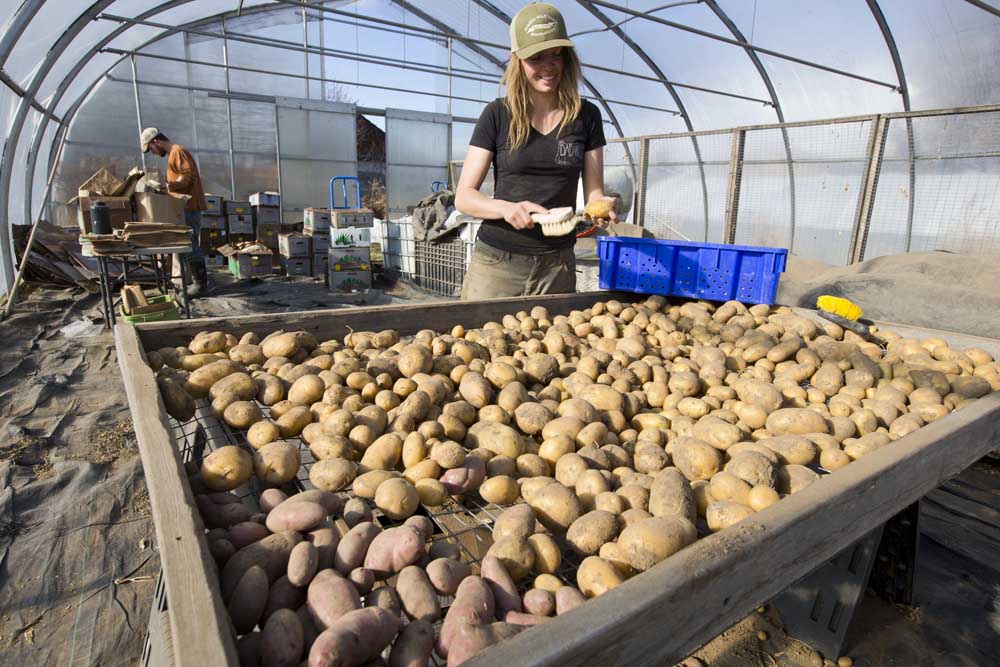A portrait of Central Oregon small farms and ranches
Published 5:32 am Thursday, November 30, 2017

- David Kellner-Rode, left, and Megan French prepare potatoes for sale while working together Nov. 16 in a greenhouse at Fields Farm in Bend. (Andy Tullis/Bulletin file photo)
A handful of ranches and small farms in Central Oregon sold $1.5 million worth of meat and produce in 2014, according to a recent study by the Oregon State University Extension Service.
The study, paid for with grants from the Ford Family Foundation and the U.S. Department of Agriculture, tried to reach more local food producers than it did, said Mallory Rahe, an OSU extension community economist in Corvallis and a report author. The survey, explained in a report, “Economic Impact of Local Food Producers in Central Oregon,” gathered data from 38 producers out of 83 the survey team contacted.
Only 28 farmers and ranchers gave complete survey responses.
Rahe said the team behind the study struggled to collect information that, in some cases, farmers and ranchers were reluctant to share.
“Ultimately we did not try to extrapolate from the farmers we surveyed to say anything about the whole industry in the region,” Rahe said Nov. 16. “We did say that of the 28 we did survey, this is their economic impact; we know it’s bigger but not how much bigger.”
Central Oregon is home to approximately 2,300 farms. They are not big money-makers, according to the report. Most are under 50 acres, and 70 percent earned less that $10,000 in gross sales in 2012, the year of the last Census of Agriculture by the USDA. Sixteen percent sell directly to consumers at farmers markets or community-supported agriculture programs, for example, compared to 19 percent of farms statewide.
The 28 farmers and ranchers who provided a complete picture of their 2014 operations farmed 10 acres or less of irrigated land. The farms were less than seven years old and grew 44 varieties of vegetables and other crops and raised eight different animals. Beef cattle and vegetables constituted the majority of sales. Together they paid nearly a quarter of a million dollars in salaries and wages that year.
Growing food or raising livestock for direct marketing in Central Oregon is a tough career chosen by those with a passion for it, said Megan French, a farmer herself and a board member at Central Oregon Locavore.
“My interest is in making food a viable career and a viable option for people,” she said.
Many farmers run their operations at a point where expanding their production by a few acres or hiring an employee might produce a significant return, or sink the operation entirely, she said. Some live below the poverty line.
“A lot of farmers, especially in Central Oregon — and this may not hold true for the Willamette Valley — are not exclusively farming,” French said. “Maybe one of the farming partners has another job that pays the mortgage. I can only think of a few people that are solely farmers.”
Its authors — Rahe, Katrina Van Dis of the Central Oregon Intergovernmental Council, Jess Weiland of the High Desert Food and Farm Alliance and Lauren Gwin of the OSU Center for Small Farms and Community Food Systems — in the report suggested three scenarios in which small farms that market directly to consumers can expand in Central Oregon.
First, they must increase production. Second, the area needs a “food hub,” basically a facility that provides an efficient, cost-effective means of storing and distributing their meat and produce. Finally, consumers need to shift their buying habits away from grocery stores and toward locally grown farm products.
“The key takeaways from this are that farmers who are really passionate about this see real business opportunities. There is demand out there; it’s growing,” Rahe said. “But producers are small and spread out, and focused on doing so many things at once that it’s hard to focus on supply and demand at a single level when they don’t have enough time in their day.”
Grocery chains benefit competitively not only by economies of scale, but by government-subsidized farming and by importing cheaper produce, French said. Shifting consumer habits has to be a choice beyond convenience, she said.
Sarahlee Lawrence, owner of Rainshadow Organics, a farm near Terrebonne, said a food hub funded and staffed by an organization such as High Desert Food and Farm Alliance would be a good start.
“They could be the distribution center that sells to local grocery stores,” she said. “I don’t have that much faith in local grocery stores, I guess. I’m hopeful.”
Buying local is often a token gesture, she said. But Lawrence said she can grow winter squash, for example, for the same price she finds in a large chain.
“I go in there and think, ‘How do I break into this?’” she said.
Rahe said the report tries to answer that question.
“This is something the local food movement struggles with,” she said. “There is this desire to be a comparable choice for people, not the hard-to-access, more expensive food. A lot of people in this space want to promote greater access to healthier food, greater awareness of alternatives to (well-known) vegetables and how to prepare and incorporate them into your diet. So how do we get this produce available to people other than Saturday morning farmers markets or CSA drop-off points? How do we start integrating them into the system so consumers have more choice?”
— Reporter: 541-617-7815, jditzler@bendbulletin.com






